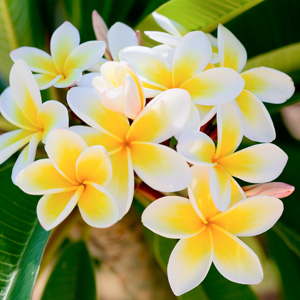The Ultimate Growing Frangipani Guide
Frangipani Growing Guide
What is Frangipani?
The Frangipani (Plumeria spp.), is a captivating plant renowned for its mesmerising scent and vibrant blooms. Originating from Central and South America, as well as Mexico and the Caribbean, it belongs to the Apocynaceae family, sometimes referred to as the ‘dogbane’ family. Most commonly recognised as deciduous small trees or large shrubs, there are several deciduous species of frangipani, shedding their leaves annually. While there are evergreen species, these predominantly thrive in tropical and sub-tropical environments, making them a popular choice for growing frangipani.
From late spring to autumn, expect a floral spectacle as frangipani bursts into colours, its range including deep crimson, pale pink, pristine white and radiant yellow, often dictated by the region’s climate.
Beyond their visual charm, frangipanis are celebrated for their intoxicating fragrance. Ideal growing conditions include sun-drenched locations shielded from harsh winds, as these tropical trees thrive best with ample humidity.

Frangipani Hawaiian Sunset – Garden Express Australia
Benefits of Growing Frangipani
The frangipani is considered one of the finest plants when it comes to aesthetic brilliance in the gardening realm. Its vibrant blooms offer a stunning visual, making it a coveted centrepiece in any garden or balcony.
The enchanting fragrance of frangipani is undeniable. Even a single blossom can infuse the air with its sweet, heady aroma, transforming outdoor and indoor spaces into aromatic retreats. Moreover, these fragrant flowers attract pollinators, inviting bees and butterflies, thus promoting biodiversity in your garden.

FRANGIPANI SHELL – Garden Express Australia
Common Questions About Frangipani
When Does Frangipani Bloom?
In Australia, frangipani primarily blooms during the warmer months, from late spring to early autumn. However, the exact timing can vary based on the region. In tropical and sub-tropical climates, the blossoms might appear earlier and last longer, while in cooler southern regions, where frangipani can be difficult to grow, the flowering window is likely to be shorter.
How Long Do Frangipani Trees Live?
Frangipanis are notably long-lived plants. With proper care and favourable conditions, a frangipani tree can thrive and produce its fragrant blossoms for many decades, with some even living for over 100 years, becoming a cherished and enduring feature in many Australian landscapes.
How Fast Do Frangipanis Grow?
Frangipanis exhibit a moderate growth rate, typically gaining 20 centimetres annually. With ample sunlight and well-draining soil, they can establish themselves steadily over time, eventually achieving their characteristic spread and height.
When Do Frangipani Leaves Grow Back?
In Australia, frangipanis typically lose their leaves during the cooler months. As temperatures rise in spring to early summer, frangipanis start sprouting new leaves, signifying their reemergence from dormancy. The fresh green foliage then thrives, preparing for the ensuing vibrant floral display.
Where Can Frangipani Grow in Australia?
In the tropical and subtropical areas of Australia, such as Queensland and northern New South Wales, frangipanis thrive splendidly. These regions provide the optimal heat and humidity levels that frangipanis adore, allowing them to flourish and showcase their resplendent blooms with minimal care.
For temperate coastal regions like Sydney, Melbourne, and parts of Tasmania, growing frangipanis can be challenging, but they can be successfully cultivated given the right conditions. Frangipanis can be grown against warm masonry walls or hot houses, providing the right microclimate. Extra measures to protect from occasional frosts and cold snaps are essential.
In the Mediterranean climates of Adelaide and Perth, frangipanis fare well due to the warm, dry summers. These conditions mirror those of their native habitats. However, ensuring they are protected from winter rains and occasional frosts is crucial. This can be done by planting them in raised beds or using free-draining soil.
How Can I Make My Frangipani Grow Faster?
Growing frangipani requires patience, but you can help your plant achieve its optimal growth rate by ensuring it receives ample sunlight, watering it regularly during the dry months and letting the soil dry between each watering. You can also use a balanced, slow-release fertiliser during its growing season. Additionally, select well-draining soil and avoid over-pruning, as this can further promote its rapid growth and robust health.

Frangipani Summer Collection 1 – Garden Express Australia
How to Grow Frangipani
Plant Size
Frangipani typically reaches heights of up to 8 metres and can spread its canopy to a width of around 4 to 5 metres. This grandeur makes them a striking addition to gardens. However, for those with space constraints or desiring a more compact look, dwarf varieties are available, offering the same vibrant blooms in a smaller form.
Despite their size, frangipani trees aren’t just confined to open gardens; they can also be cultivated in pots. Opting for container gardening allows for flexibility in positioning, making it a great choice for those with limited garden space. When growing frangipani in pots, ensure the container is large enough to accommodate growth and that it has excellent drainage. Dwarf varieties are particularly suited for pot cultivation.
When To Plant Frangipani
Planting frangipanis at the right time is crucial to ensure their healthy growth. In tropical and subtropical regions, the best time to plant is during late winter to spring. This period provides the young plants with a favourable environment, aiding in proper root establishment.
For temperate coastal, maritime, and Mediterranean climates, the optimal planting time is the early spring months, from September to October. This allows the plants to take advantage of the warmer temperatures and longer daylight hours, fostering robust growth before summer.
Soil Preparation and Potting Mix
Frangipanis thrive in a variety of soil conditions, but well-draining soil is paramount to prevent root rot and ensure healthy growth. Frangipanis are averse to prolonged moisture around their roots, often referred to as “wet feet.” When opting to grow them in containers, it’s vital to select the best potting mix for frangipani. This mix should be of high quality and provide ample drainage, allowing the plant to flourish without the risk of excessive moisture retention.
Where to Plant – Does Frangipani Need Full Sun?
Frangipanis are sun-loving plants that thrive when planted in locations receiving abundant sunlight. Ensuring the crown sits at soil level, it’s advisable to provide them with a spot that basks in full sun for most of the day. Especially in cooler climates, placing them near a brick wall not only offers extra warmth through radiant heat but also acts as a barrier against chilly winter winds, promoting robust growth.
Can frangipani grow in shade? While these plants prefer sunlit conditions, they can tolerate partial shade. However, their flowering may be reduced, and the vibrant colours of their blossoms might be less pronounced compared to those grown in full sun.
Ongoing Frangipani Plant Care
For optimal growth, it’s essential to consider the local climate when watering your frangipani. In tropical regions where the warm months coincide with the wet season, water your frangipani primarily during the dry season. In other climates, where the warm season aligns with the dry season, water during the warmer months. Always allow the soil to dry out between waterings, as frangipanis prefer not to have ‘wet feet’.
Fertilising is vital for robust growth and vibrant blooms. Apply a fertiliser rich in phosphorus and potash twice a year, once in spring and again in summer. This not only fortifies the root system but also enhances the beauty of the flowers.
Pruning isn’t typically necessary for frangipanis. However, if you wish to manage its size, remove damaged or diseased branches, or address branches that have begun to rub or cross over one another, some selective pruning can be beneficial.
When cultivating frangipanis in containers, ensure you choose a high-quality, free-draining potting mix. Repotting every 3 to 4 years will keep the plant healthy and thriving.
Pest and Diseases
To prevent diseases and pests from affecting frangipanis, it’s crucial to implement good gardening practices. Overwatering is a common cause of root rot; therefore, using a well-draining soil and allowing it to dry out between waterings can help. Additionally, practising proper spacing between plants helps with airflow, reducing the risk of fungal diseases. Regularly inspecting the underside of leaves can help in early detection of plant rust, allowing for timely intervention.
If you notice any signs of plant rust, immediately treat your frangipani with a copper-based spray. Ensure you remove and discard the diseased parts to halt its spread. For fungal diseases like downy and powdery mildew, eco-friendly fungicides can be effective. Always follow label instructions when applying treatments and consider regular applications during humid or wet periods, as these conditions are favourable for fungal growth.

Frangipani Summer Collection – Garden Express Australia
Frangipanis from Garden Express
Garden Express is proud to offer an extensive range of plants to make your garden stand out. Located in the Dandenong Ranges, this scenic location boasts an array of ornamental gardens and agricultural crops. With vibrant bulb farms, tulip fields, fragrant roses and the enchanting frangipani, the Dandenong Ranges and bordering Yarra Valley is a haven for gardeners.
To learn more about frangipanis or start growing your own, reach out to us on 1300 60 6242, drop by our location for a visit, or explore our extensive frangipani collection online.






